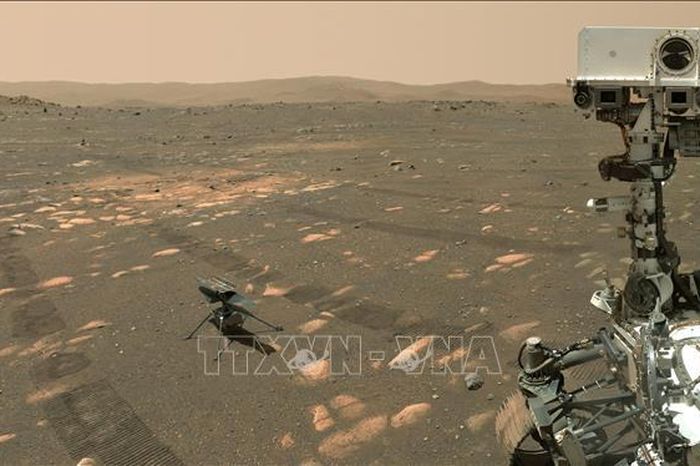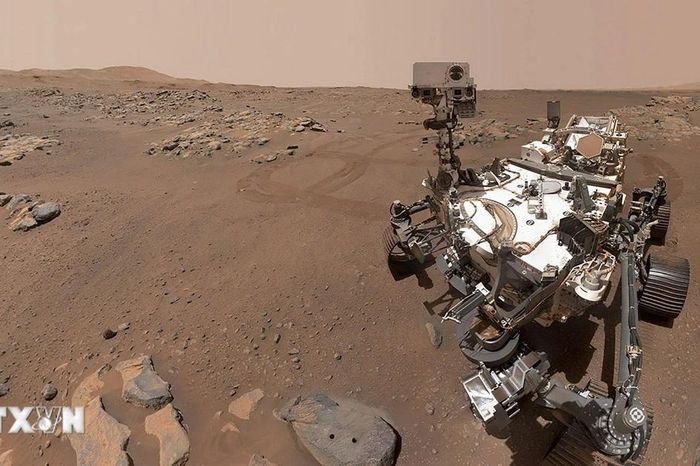The US tested robots operating on the Moon
The robot, named Spirit, will test how to move on the rugged terrain of Mount Hood in the state of Oregon, USA. Accordingly, the robot must move on difficult and variable surfaces, walking from hard or rocky surfaces, to soft ground surfaces such as snow or sand.

Dr Cristina Wilson of Oregon State University, said: 'With each step a four-legged robot takes, it can feel mechanical resistance to its legs, similar to the way humans walk on surfaces. On uneven surfaces, we can detect how the ground is moving under our feet; a robot with legs has the same ability. Through this, we can collect data to further our understanding of how the planet's surface was formed and how it will move in the future."
The research project, called Project LASSIE: Automated Surface Science in Analog Environments, demonstrates that the Spirit robot can learn to navigate and adapt to each new challenge, in preparation for future missions. destiny in the future when humans and robots work together in space. The Mount Hood terrain robotics efforts will help design future machines and how they deal with different terrains and how they collect data as they move.
'My team's role in this project is to ensure the robot can sense and maneuver for planetary science,' said Feifei Qian - Assistant Professor of Electrical and Computer Engineering at the University of Southern California. That means we want the robot to be able to move from place to place, to get to the points where we want to take any measurements. Second, we are doing something very novel which is turning each leg of the robot into a sensor so that as the robot takes each step, we want the robot to collect information about the environment."
The project is sponsored by the US Space Agency NASA for a period of 2 years with a total value of up to 2 million USD, allowing robot groups to support astronauts in performing many different tasks on the moon. The research team includes experts from NASA, Texas A&M University, Georgia Institute of Technology, Oregon State University, Temple University and the University of Pennsylvania.
You should read it
- Here's your chance to design a NASA payload for a Roomba-sized moon rover
- NASA opens the entire library of photos, videos and audio for free, anyone can see
- NASA will prioritize the recruitment of experienced scientists in blockchain and cryptocurrency
- NASA's top secret inventions have just been revealed
- NASA launches new Sun tracking tool
- Did NASA ships indirectly bombard other planets?
- Why didn't NASA intend to return to the Moon?
- How to watch NASA and Russia launch a new crew to the ISS on Thursday
May be interested
- We may be able to see the 'second moon' in the sky with the naked eye next May
 this second moon is actually a comet called atlas (original name is c / 2019 y4) will have the same brightness as our moon and is heading towards earth but not crashing.
this second moon is actually a comet called atlas (original name is c / 2019 y4) will have the same brightness as our moon and is heading towards earth but not crashing. - Unexpected discoveries of the full moon
 this phenomenon is always associated with mystical stories that make scientists headaches.
this phenomenon is always associated with mystical stories that make scientists headaches. - Why didn't NASA intend to return to the Moon?
 in 1969, nasa made history when it completed the mission to set foot on the moon. since then, conquering the moon has become the ambition of many countries around the world. but why has nearly 50 years passed without nasa planning to return to the moon?
in 1969, nasa made history when it completed the mission to set foot on the moon. since then, conquering the moon has become the ambition of many countries around the world. but why has nearly 50 years passed without nasa planning to return to the moon? - Why is the moon glowing?
 we all know the extremely familiar natural phenomenon: the sun shines in the daytime, the moon shines at night. so, where is the light that the moon glows?
we all know the extremely familiar natural phenomenon: the sun shines in the daytime, the moon shines at night. so, where is the light that the moon glows? - Admire Anymal robots that can use elevators like people
 anymal, a robot mentioned a few years ago at eth zurich, will soon be commercially available and no longer needs human support when riding the elevator.
anymal, a robot mentioned a few years ago at eth zurich, will soon be commercially available and no longer needs human support when riding the elevator. - New technology helps NASA find water, self-sufficient food on the moon
 nasa is stepping up the preparation of technologies necessary both in terms of vehicles, people and logistics to serve the purpose of ambitious moon recovery.
nasa is stepping up the preparation of technologies necessary both in terms of vehicles, people and logistics to serve the purpose of ambitious moon recovery. - The biggest super moon in 70 years will appear on November 14
 let's observe the 21st century super moon on november 14, 2016!
let's observe the 21st century super moon on november 14, 2016! - What's interesting is what happens if the Moon is 400km from Earth?
 according to the analysis of scientists, with that distance, the moon cycle will become faster than earth. meanwhile, the moon will grow in the west and dive in the east every day.
according to the analysis of scientists, with that distance, the moon cycle will become faster than earth. meanwhile, the moon will grow in the west and dive in the east every day. - Top 10 interesting facts about the Moon you may not know
 start a trip to the moon to discover the top 10 interesting facts about it!
start a trip to the moon to discover the top 10 interesting facts about it! - Can people and robots give birth together in 100 years?
 dr. david levy, a leading expert in the field of artificial intelligence, is based on recent advances in science when the study of artificial stem cells and chromosomes has been predicted, within 100 years. robots can be born with children.
dr. david levy, a leading expert in the field of artificial intelligence, is based on recent advances in science when the study of artificial stem cells and chromosomes has been predicted, within 100 years. robots can be born with children.










 The Ingenuity exploration helicopter on Mars sends final information back to Earth
The Ingenuity exploration helicopter on Mars sends final information back to Earth Rare volcano spits out real gold
Rare volcano spits out real gold The Hubble Telescope finds a galaxy glowing strangely from behind a dark nebula
The Hubble Telescope finds a galaxy glowing strangely from behind a dark nebula Space junk breaks through the roof of a house in Florida
Space junk breaks through the roof of a house in Florida NASA is looking for a less expensive way to bring Martian rock and soil back to Earth
NASA is looking for a less expensive way to bring Martian rock and soil back to Earth 'City killer' 610 m rushes to Earth, can be seen tonight
'City killer' 610 m rushes to Earth, can be seen tonight